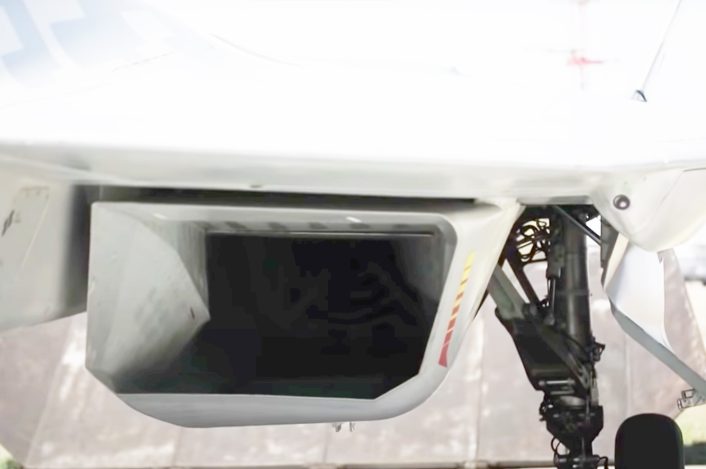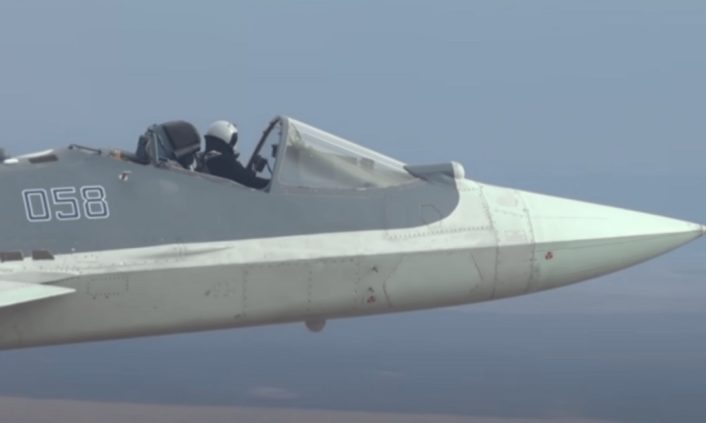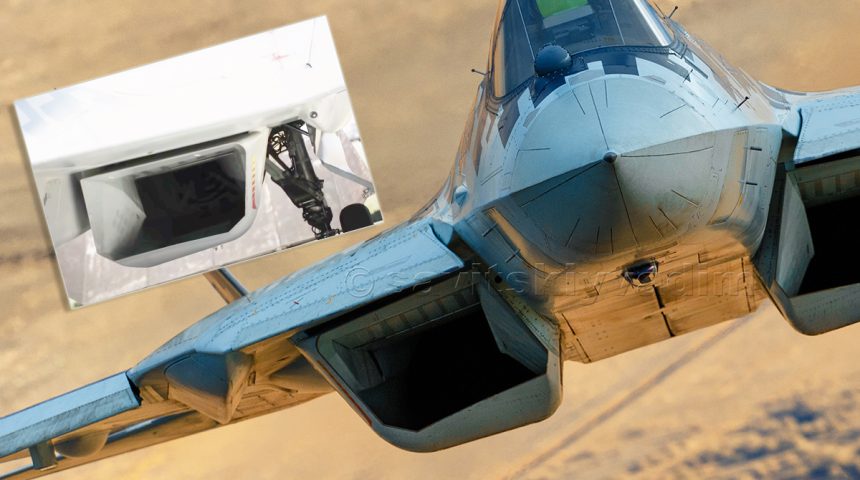The Su-57 Felon’s radar blockers were allegedly exposed by a video part of a longer feature aired by Russian television for the centenary of the Chkalov State Flight Test Center.
The V.P. Chkalov State Flight Test Center in Akhtubinsk (Russia), the largest test center of the Russian Aerospace Force, celebrated in October its 100th anniversary. For the occasion, the Russian TV Channel One was allowed to visit the airport and showcase its activities. Towards the end of the video, the focus moved to the new Sukhoi Su-57 “Felon”, showing some details of the fifth-generation fighter aircraft’s air intake.
As the test pilot started the engines the framing showed the flight surfaces repositioning as the hydraulic system came online and, in particular, the wing’s leading-edge extensions (which act as maneuvering flaps) as they raised themselves, leaving a clear visual of the left engine air intake.
As we already reported, the Su-57 uses a S-duct air inlet which does not cover the entire engine faces, as done for the F-22 Raptor and the F-35 Lightning II, leaving it exposed to radar signal reflection. The problem was said to be mitigated by a radar blocker that, however, was never seen on the prototypes.
И в продолжение предыдущей новости от любителей: pic.twitter.com/jppQBpLs46
— Frazor Felon (@FelonFrazor) December 7, 2020
Using some quick color manipulation on screenshots from Channel One’s video, some observers on Twitter claimed they were able to unveil for the first time the Su-57 radar blocker.
Кстати, рисунок блокера публиковали ещё в 2013 году:https://t.co/QoBoLXaE3i pic.twitter.com/rrXhtG7GFr
— Слава Третий (@SlavaTheThird) December 6, 2020
We have tried to edit a screenshot from the video but weren’t able to obtain the same level of details so we can’t be sure the image included in the Tweet above wasn’t doctored. Anyway, the blocker may actually be composed by more pieces and this one might be the first to be hit by the air flow entering the inlet. The aircraft appears to be the eight flyable prototype, bort number 509, which was reportedly used to test the final version of the avionics and should be also the third flyable prototype of the second-stage development.

The second-stage most noticeable difference is the new engine specifically developed for the Su-57, known as Izdeliye 30 (literally Product 30), but, since the engine is not yet ready for production and tested only on an earlier prototype, the aircraft is still using the Saturn AL-41F-1, derived from the Su-35 Flanker E’s engine. The Product 30, which should provide 18’000 kgf of thrust instead of the 15’000 kgf of the current engine, is supposed to be more efficient than previous designs and able to give the Felon a top speed in excess of Mach 2 and a supercruise capability at Mach 1.3, featuring also 3D thrust vectoring and a “stealthier” nozzle.
#PHOTO The fifth-generation fighter #Sukhoi Su-57 (T-50, PAK FA flying laboratory) with a second-stage engine.
Pics Michael Polyakov pic.twitter.com/L2HNOszbcK
— UAC Russia (@UAC_Russia_eng) March 16, 2020
The Russian news agency TASS recently stated that UEC-Ufa Engine Production Association (part of the United Engine Corporation within Rostec) will begin the production of the Product 30 engine in 2022, with the first serial deliveries of the Product 30-equipped Su-57 in 2023. The engine prototypes should be in the final testing phase.
Later in the video, the seventh flyable prototype, bort number 058, was shown inflight without its canopy. This segment of the video was also posted by the Russian Ministry of Defense on YouTube and widely reported online. While a similar flight could seem strange at first, it’s possible that it was related to testing for the aircraft escape system. Similar testing was performed also on western aircraft in the past, with the Tornado being a well-documented example. Another well-documented episode of a similar situation, but this time not for testing, is the F-14D Tomcat which in 2002 landed without canopy and rear seat because the RIO accidentally hit the ejection handles.
Quick observation: the tolerances on the skin panels here are significantly better than what we saw on the 11 pre-production aircraft. https://t.co/jcrvjM5yEV
— Steve Trimble (@TheDEWLine) August 12, 2020
The Su-57 was often criticized for the lack of some stealthy features, like exposed rounded surfaces, rough panel’s seamlines, etc. Many of these seem to be missing, or at least reduced, on the aircraft that are now being built serially, as it was visible on the second Su-57 (T-50S-2/51002) under construction this summer. The first photos were released after a visit of the Russian Defense Minister at Sukhoi’s Komsomolsk-on-Amur (KnAAZ) plant. Experts noted an improved manufacturing quality, together with some other differences like the IRST (InfraRed Search and Track) sensor covered by RAM (Radar Absorbing Materials) while in the stowed position, modified air inlets at the base of the vertical tail stabilizers and better sealed panel gaps.
С опозданием, но зато с видимым изменением качества поверхности: pic.twitter.com/CgTpO1tBiW
— Frazor Felon (@FelonFrazor) August 21, 2020
The first serial production Su-57 will be delivered by the end of the year, according to TASS. The aircraft is actually T-50S-2, the second of the 76 currently on order, as the first serial production aircraft crashed at the end of 2019 during flight testing because of a failure of the tail control system. This accident is the first Su-57 lost since the first flight in 2010. As we mentioned before, this first aircraft, which flew for the first time last month, will be delivered with the older first-stage AL-41F-1 engine. Deliveries of this first serial batch of Su-57 should be completed by 2028.
Ныне покойный первый серийный (публикуется впервые): pic.twitter.com/EshJoFeAxy
— Frazor Felon (@FelonFrazor) December 4, 2020
Even before the first delivery, a major upgrade is being developed for the second-stage. The final configuration of the second-stage will fly for the first time in 2022 with, other than the Product 30 engines, new avionic, new guided weapons and the hydraulic actuators of the flight controls replaced by electromechanical actuators. The upgrades will reportedly reduce maintenance costs and increase the efficiency.
Microsoft HoloLens pic.twitter.com/JDp2NO4dtJ
— 笑脸男人 (@lfx160219) December 10, 2020
In the last few days, more images and videos of the serial production of the Su-57 surfaced on Twitter. The videos show Sukhoi workers are using Augmented Reality during the assembly of the Su-57 and, according to some sources, the headsets used seem to be the Microsoft Hololens (or a clone). The system is employed during a number of processes during the production, with some examples showing its usage on the fuselage and the landing gear.

It has also been reported that the Su-57 will have an export version, known as Su-57E, announced during the Army-2020 international military and technical forum in Russia this summer. No details are known however about this variant, but it’s safe to say that the Felon will have degraded performance, capabilities and avionics, similarly to the export variant of other fighter aircraft. Like happened in 2019, unverified reports begun circulating about a sale of the Su-57E to Algeria, however the Russian government stated that the Russian Aerospace Forces have the priority over the export variant, so it’s unlikely that there will be any international orders at this point.









